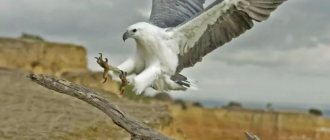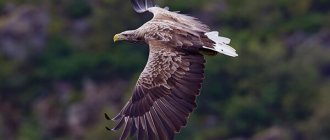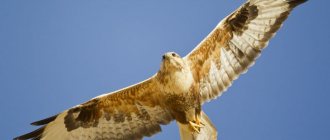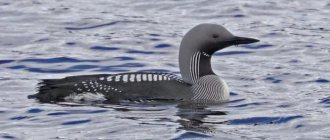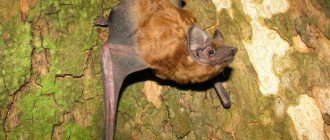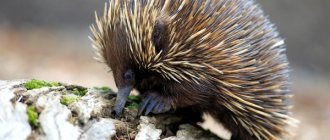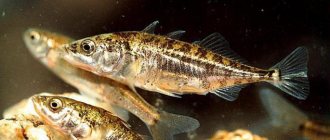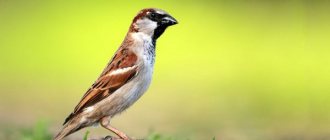- Wild animals
- >>
- Birds
Many people dream of seeing a bird like the Steller's sea eagle . Even being far in the sky, it amazes everyone with its power, because this species is one of the most massive and largest. All birds of the hawk family also attract with their extraordinary beauty and lightning speed. But first of all, it is important to note that this representative of the hawk is a very cruel predator. Well, let's take a closer look at the life of the Steller's sea eagle.
In this article:
|
Habitat
The coast of the Sea of Okhotsk and the Kamchatka Peninsula is inhabited by Steller's sea eagles. These predators are common in the Penzhina River valley in the south of the Koryak Highlands. In addition, huge birds are found on the Kuril Islands, along the Amur, in Korea and in the northern part of Sakhalin. Eagles often fly to visit northern China, Japan and North America. But outside Russia, Pacific eagles stay exclusively during the winter migration period.
Predators build nests only in Russia. Migrations in the cold season occur twice - from March to May, then from the end of October. Birds can travel during seasonal migrations not only in small groups, but also alone. In autumn and winter, eagles rarely fly into the taiga, preferring to stay close to food - on the sea coasts.
FEATURES OF WINTER FISHING
In winter, eagles have a much more difficult time. They do not fly far from their usual places. Some remain near their native nest, others go to the shores of Korea, etc. In winter, the main thing for the bird is the availability of unfrozen water so that it can hunt. Several dozen birds can gather in such places at the same time. If the ice holes are covered with ice, you have to supplement with waste or steal from fishermen. Yes, and this happens: sometimes eagles gather in groups in ice fishing areas, not far from the fishermen sitting on the ice floes, and wait: what if they get lucky? And when you are unlucky, many birds die from exhaustion.
Many people confuse bald eagles with eagles. But these birds are not close relatives at all. Eagles are larger than eagles, and they differ in appearance: they have unfeathered legs and a wedge-shaped tail. By the way, the famous symbol of America “ white eagle”
"- not an eagle at all, but a bald eagle, the closest relative of our Steller's sea eagle.
Description of the bird
The Steller's sea eagle is a true giant among birds; its length can be as much as 115 centimeters. The length of the wings of this predator varies from 57 to 69 centimeters, and their wingspan reaches 2.5 meters!
Oddly enough, male Steller's sea eagle are smaller than females. The average weight of a boy varies from 7 to 7.5 kilograms, while girls weigh from 8 to 9 kilograms. Larger females were recorded, weighing more than 12 kilograms.
Solid dark brown plumage is rare; most birds described wear a “fur coat” of harmonizing colors - dark brown and white. The main background is brown, on which white feathers appear in bright spots - on the wings, tail, legs and forehead. Eagles acquire this costume by the age of 4-5; young individuals look more modest - light feathers are mottled against a dark brown background.
The beak and paws of the bird stand out with bright spots - they are yellow and sometimes orange. The claws are black and have special spikes that securely hold prey.
It is impossible to distinguish a male from a female by color; the only difference is weight. Eagles begin to change both small and large feathers at the same time, and molting lasts from May to October.
Appearance and features
Photo: Steller's sea eagle
Like all other sea eagles, the Steller's sea eagles are quite massive. However, in size it is still slightly larger than its relatives in appearance. The total length of the bird's skeleton is approximately 110 centimeters, and its weight can even reach 9 kilograms. The Steller's sea eagle has incredibly beautiful light brown eyes, a massive yellow beak and yellow feet with black talons. Thanks to its long fingers, the bird can easily hold its prey, hitting its vital places with its rear claw.
Interesting fact: The Steller's sea eagle has a very distinctive yellow beak. It is visible to humans even in very heavy fog. Fishermen of the Far East took advantage of this. If they saw a flying bird with a bright yellow beak, then this signaled to them that it was soon approaching land.
Due to its large size, the bird is not able to move long distances. They typically fly only about 30 minutes a day. It is this factor that forces individuals to nest as close as possible to the shore or any body of water, although this is not safe, because usually these places contain large crowds of people.
As a result, the Steller's sea eagle is distinguished from other species of the hawk family by its white “shoulders”, body length and wingspan, as well as its incredibly yellow beak. Its graceful, leisurely flight adorns the skies of settlements located near water.
What does the Steller's sea eagle eat?
These birds are not scavengers, like many of their kind. They hunt and eat only live and fresh food. Hunting takes place only during the day; at night the birds are inactive. Due to their large size, Steller's sea eagles cannot fly for a long time; daytime flights do not exceed 30 minutes in total, so they settle closer to the coast on the rocks.
The diet is dominated by large and medium-sized fish; birds give particular preference to salmon. The Steller's sea eagle is a thunderstorm for seals; it loves to feast on pups that their parents haven't kept an eye on. Also, the predator will not refuse small mammals - these are hares and arctic foxes. Birds are also on the menu; the eagle hunts wood grouse, gulls, partridges and ducks. Sometimes the predator also feeds on invertebrates - crabs and mollusks.
An eagle hunt is a stunning spectacle. The bird first begins to majestically circle in the air, looking for lunch. As soon as the prey has been spotted, the predator rapidly begins to descend, but not in a dive (its weight and size do not allow it), but in a parabola, circling in the air, like a falling leaf. Then the bird grabs the prey, holding it firmly in its claws, and flies away. Nothing remains from the eagle's prey; its powerful beak crushes even bones.
NEST-FORTRESS
The eagle is a large bird, so its nests are also rather large. A newly built one can reach 1 m in diameter and almost the same in height. However, birds of prey do not build a nest anew every year, as small passerines do, but only renovate and build on the old one. And after a few years, the building often reaches simply enormous dimensions - up to 3 m! It can easily accommodate 2-3 people. The main building material of the nest is large tree branches, and the tray is lined with smaller branches and dry grass. Nests are located on large trees with a flat top, at the very top, and sometimes on rocks. The fact is that with such long and wide wings and a massive body, the eagle simply would not be able to fly up to the nest if it were “hidden” somewhere in the middle of the trunk.
Reproduction
Steller's sea eagles are monogamous birds; a pair stays together throughout their lives. But, despite this fact, both males and females can sometimes “cheat” on their spouse. A DNA test made it possible to find out about this, which found half-brothers and sisters of chicks not only in neighboring nests, but also in one.
These birds reach sexual maturity in the fifth and sixth years of life. They build a nest in which the first eggs will be laid. Mating games take place in March, and laying occurs from April to May.
The eagle lays 1 to 3 eggs, which have a beautiful greenish tint. It happens that the egg is destroyed, then the bird lays another one. Only the mother is involved in hatching the chicks, while the male is responsible all this time for ensuring that the wife does not remain hungry. The chicks hatch 35-36 days after the egg was laid. Parents will take care of their offspring for 2-2.5 months, after which they will fly out of the nest. Children stay close to their parents for some time, and then leave them.
Steller's sea eagles are caring parents. They feed the children three times a day with small fish. They recognize their offspring, even if they have not seen them for many years. Birds will protect their young in any case, saving them from larger predators, even bears, if necessary.
About 15% of Steller's sea eagle chicks die before they reach adulthood. Most often, nests are stolen by crows and other predators; babies can get sick from hypothermia. It happens that small chicks become victims of their larger brothers and sisters.
Taxonomy
Russian name
— Steller's (or Pacific) eagle
Latin name
— Haliaeetus pelagicus
Squad
- Falconiformes
Family
- hawks
Europe first learned about the “pied magpie eagle” from naturalist Georg Steller, a participant in the First Kamchatka Expedition. Since then, in many countries the Steller's eagle is called Steller's eagle; its English name is Steller's sea eagle.
Conservation status
The Steller's sea eagle is included in the IUCN Red List (vulnerable species with a declining trend), in the list of threatened bird species in Asia and in the Red Book of the Russian Federation. The global population is only about 5,000 individuals (BirdLife International, 2015), of which 43% live in the Lower Amur region and on the island. Sakhalin. The Steller's sea eagle is endemic to the Far East, i.e. It does not nest anywhere outside this region.
Species and man
In nature, adult Steller's sea eagles have practically no enemies, so the main threat to them is humans, who have both a direct (shooting) and mainly indirect impact on the size and condition of the population of this species.
Due to their gigantic size, Steller's sea eagles are capable of flapping flight for no more than 30 minutes a day, which limits the range of their movements. Therefore, birds are forced to nest as close as possible to the shoreline of feeding reservoirs - on average no further than 65 m (N = 1047). But it is the coast that is most intensively used by humans for recreational and economic purposes, which harms the nesting of eagles.
Reduction of necessary food resources, environmental pollution, transformation of habitats and the impact of disturbance factors affect the occupancy of nests and the success of population reproduction. River pollution Amur industrial effluents, depletion of fish stocks (primarily salmon), deforestation and the development of plans for the construction of a cascade of hydroelectric power stations that can radically change the hydrological regime of the river and the entire ecosystem of the Amur floodplain, as well as the global development of shelf and coastal hydrocarbon deposits on the island. Sakhalin raises serious concerns for the fate of Steller's sea eagles in the southern part of their range. There is a potential threat of mass bird mortality in the event of large-scale oil spills.
Previously, Steller's sea eagles suffered most during their wintering grounds in Japan, where Japanese samurai shot these birds to decorate their arrows with the white tail feathers of eagles. Subsequently, there in Japan, eagles died from lead poisoning after feeding on the carcasses of deer killed but left on the shore.
Among the indigenous peoples of the Far East, the bright yellow beak of eagles served as a kind of beacon, clearly visible even in heavy fog. A meeting with this handsome yellow-billed creature told the fishermen that land was approaching.
Spreading
Steller's sea eagles nest only in Russia - on the coast of the Sea of Okhotsk, the Kamchatka Peninsula, Sakhalin Island and in the Lower Amur region
Seasonal migrations take place singly or in small groups in the spring from late March to mid-May and in the fall - at the end of October and November.
Appearance
The Steller's sea eagle is the largest and most spectacular eagle on the planet (Meyburg 1994). The weight of adult females reaches 9 kg, males are slightly smaller - up to 7.5 kg. The total length of the birds is 105-112 cm, the wingspan is more than 2.5 m.
The color of the Steller's sea eagle is a surprisingly beautiful combination of dark brown and white colors. Against a dark background, white spots on the wings (hence the name), white tail feathers, a white forehead and white “pants” (feathering of the lower leg) stand out clearly. All this makes the Steller's sea eagle one of the most beautiful birds of our fauna. True, this outfit is typical only for adult birds, and they don it no earlier than 4 years of age. (And they acquire a full adult outfit only at 5-6 years old!). Young Steller's sea eagles have uniform brown plumage with light streaks. The bright yellow beak and the same color paws with powerful black claws stand out against the general background. There is no sexual dimorphism (i.e., difference between males and females) in the coloration of Steller's sea eagles.
During the flight of eagles, the primary flight feathers on the wings are arranged in a finger-like manner.
Nutrition and feeding behavior.
Bald eagles feed almost exclusively on fish. With its powerful paws with sharp claws, the bird deftly snatches large fish from the water, sometimes weighing up to 4 kg. To hold slippery and heavy prey, strongly curved claws and special spikes on the inside of the fingers are used.
The eagle cannot dive like an osprey (another fish-eating predator); it grabs prey from the surface of the water. Possessing great weight, the eagle does not dive at its prey; it quickly descends in a parabola, turning over and gliding in the air.
During the spawning of salmon fish, the Steller's sea eagle almost completely switches to feeding on them, and not only catches live fish, but also willingly eats dead spawned ones (sometimes even more willingly than live ones). The eagle eats all the fish without a trace. Heads, ridges, fins - everything is broken by a powerful beak.
In addition to fish, the diet of bald eagles includes various water birds (especially if a pair of eagles lives near the bird colony), mammals (for example, seal pups), sea debris, carrion). And yet, despite such diversity, Steller's sea eagles are typical.
Activity
The Steller's sea eagle is a typically diurnal predator. His entire active life occurs during daylight hours.
Vocalization
The voice of the Steller's sea eagle is a ringing squeal, especially often and far audible during the mating season.
Social behavior
Steller's sea eagles live in separate pairs at a fairly large distance from each other. However, in the most favorable, “fishy” places, couples can settle at a distance of 1-1.5 km from each other. There are no conflicts between neighboring pairs.
At wintering grounds, in places rich in fish, a large number of eagles can gather simultaneously. For example, in the basin of Lake Kurilskoe in Kamchatka, up to 200-300 individuals of Steller's sea eagles gather in winter. There is no particular competition between them, since if there is a lot of fish, there is enough for everyone, and if there is not enough, the birds quickly disperse and move to another place.
There are practically no food competitors for Steller's sea eagles; on the contrary, they themselves can periodically commit robbery, taking away caught fish from weaker white-tailed eagles.
Reproduction and parental behavior.
Steller's sea eagles form pairs at the age of about 4 years. At this time, the pair may even build a ritual nest in the fall, but do not nest in it. Full nesting begins when the birds reach the age of 7 years.
The Steller's sea eagle nests in trees, high from the ground (6-11 m), for many years in a row in the same nest. There may be nests on the ground or on rocks. It makes nests both on the sea coast and in river valleys. Mating games begin in March, mating takes place on the nest. Eggs are laid in April-May, while still in the snow. There are usually 2 light eggs in a clutch (rarely 1 or 3). The size of the eggs is 58-65x78-85 mm, weight is about 150 g.
Sometimes one pair has 2 nests nearby, which they use alternately. One nest is used for 5-8 years, sometimes up to 15 years. As a result of annual repairs and renovations, the nest grows and reaches 3m in diameter and 2m in height. There are often cases when the tree cannot withstand such weight, and the nest collapses to the ground (often, unfortunately, with eggs or chicks).
Incubation, like all birds of prey, begins with the first egg, so the chicks in the nest are of different ages. Incubation lasts 34-36 days. During the incubation period, the female practically does not leave the nest; the male feeds her. The chicks appear in May and stay in the nest for 2-2.5 months, flying out at the end of July and August.
Parents feed the chicks with fish 20-30 cm long, bringing food to the nest 2-3 times a day. Until mid-October, the brood stays within the boundaries of the parent site or close to it.
The death rate of Steller's sea eagle chicks is quite high, and the main reasons for this are: predation on the nests of sable, ermine and carrion crows, hypothermia (if the disturbed parents are absent from the nest for a long time). Cainism also plays a certain role, when older chicks kill younger ones. Typically, the nesting success of Steller's sea eagles does not exceed 30-70%, even in protected areas.
Lifespan
There is little data on the life expectancy of eagles in nature; it is believed that it does not exceed 18-20 years. In captivity, these birds live much longer. For example, in the Sapporo Nature Reserve on the island of Hokkaido in Japan, one Steller's sea eagle lived for 54 years.
The story of life at the zoo
Steller's sea eagles live well in captivity and are now kept in 100 zoos around the world. They also live in our zoo. Today, in total, there are more than 10 of these eagles in the collection of the Moscow Zoo, and one pair can be seen on display (in the Old Territory in a separate enclosure on the Rock of Birds of Prey), and the rest of the birds live in a calm environment in the nursery. There are currently 2 breeding pairs and their chicks of different ages.
In 1987, for the first time in world zoo practice, the Moscow Zoo achieved breeding of Steller's sea eagles. Moreover, the most valuable thing is that the couple not only laid an egg, but also raised the chick on their own. Since then, Steller's sea eagles have bred in our zoo for almost 20 years. Then there was a rather long break, and in 2014 the pair kept in the nursery again produced offspring. The next year, the second pair also bred there. It is interesting to note that several times eagle eggs were placed on a pair of steppe eagles, which successfully raised the offspring of others.
The daily diet of the Steller's sea eagle at the Moscow Zoo includes 700-800 g of meat, 200-800 g of fish (depending on the time of year) and 1 rat.
The full-fledged creation of an artificial population of the Steller's sea eagle began in 1994, when specialists from EARAZA and M.V. Lomonosov Moscow State University initiated the “Steller's sea eagle” project on the basis of zoos and nurseries. In 1995, the publication of the “European Stud Book” began (Kurilovich, 2016). An employee of the Moscow Zoo became the coordinator of the project and the leader of the stud book. Since the beginning of the project, the population of Steller's sea eagle in captivity has increased several times, mainly due to birds born in captivity.
To date, a stable captive population of Steller's sea eagles has been created, numbering more than 300 adult individuals, which are kept in more than 100 zoos and breeding centers.
About 400 chicks have already been raised in captivity. The annual increase ranges from 23 to 45 chicks and continues to increase every year. The captive population is balanced in age and sex composition and has the necessary genetic diversity. Due to the offspring obtained in captivity, the demand for birds among zoos and nurseries is fully satisfied and there is no need to remove them from the wild.
Nesting
The eagle's nest, like a bird, is huge. It is built from large branches, which are placed as high as possible - on rocks and trees. One pair can have several nests, and they are not always nearby; often the dwellings are located almost a kilometer from each other. Every year, eagles repair their nests and build on them; often the structure grows up to a meter in height and up to three in diameter. This space can easily fit two adults. It happens that the tree cannot withstand such weight, and the house falls down. You will be lucky if at this time it is empty - without clutches and already hatched offspring.
The Steller's sea eagle is a legend among all birds. He has a royal look, regal bearing, incredible intelligence, grace, beauty and enormous size. Not a single bird, even among large predators, has all these qualities at once.
Amur region
Status: III category. Rare vagrant species with limited distribution.
Spreading
Within the Amur region, only one meeting was registered: noted near the village. February
Number
The number in the Amur region is not determined, because The species in this area is a vagrant.
Source: Red Book of the Amur Region: Rare and endangered species of animals, plants and mushrooms / Rep. ed. Kozhemyako O.N. et al. (2009). Blagoveshchensk: BSPU Publishing House
Tale of a Bird
The symbol of the Magadan Reserve is the Steller's sea eagle. It was there that they decided to create a fairy tale for children, from which they would become acquainted with the bird in a language they understood.
The book is about a 12-year-old boy who, together with a group of schoolchildren, visited the library on a magical Library Day. At this time, all the heroes of fairy tales and stories come to life. At some point the boy fell behind the group because he was looking at a book about a Steller's sea eagle, and then the hero appeared before the child in all his glory! What happened next can only be read in the fairy tale itself.
Natural enemies of Steller's sea eagles
Photo: Steller's sea eagle
As you know, eagles are the largest birds of prey, so they can be said to have practically no natural enemies. However, there are many other factors that interfere with their normal life in the natural environment.
Take, for example, the fact that this genus is at the top of the food chain. It is because of this that a large amount of toxins accumulate in their body, which can cause negative consequences on the functioning of their internal organs. By the way, these same toxins are precisely contained in the bodies of the animals they eat.
Steller's sea eagle in the Red Book
Today there are not so many of these birds left, according to approximate estimates of scientists - no more than 7.5 thousand individuals. The reason for the decline in numbers was the destruction of nests by predators and humans.
The habitats of eagles are increasingly visited by tourists who pollute the environment, and this also causes a decline in the population of the most beautiful of birds.
This eagle is listed on the IUCN - International List of Nature Conservation. In addition, the eagle is recorded in all the Red Books that exist. In them, the handsome Steller is listed as a vulnerable species, and the population trend tends to decline.
Population and species status
Photo: Steller's sea eagle
Like most species of the hawk family, the Steller's sea eagle is vulnerable. As we mentioned above, this representative of the fauna has practically no natural enemies, so the main threat is humans. People build factories that pollute water bodies and interfere with the normal nutrition of these birds. Previously, some peoples also shot Steller's sea eagles, as their feathers served as an excellent decoration. Even today, in Russia, there are cases of nests being ruined and falling due to unorganized tourism.
Many scientists are focused on increasing the number of this species. Nature reserves are being built to care for birds. These measures are applied in several regions that are known for their environmental pollution.
The secret of plumage
As already written earlier, this type of bird is endowed with incredible intelligence. They try not to get into fights just like that, even for a place with their fellow tribesmen. Eagles see each other from afar, their plumage contributes to this. They do not fly to an occupied place for hunting and nesting.
This behavior is not related to the breeding of the birds, but to their weight. It was previously written that they do not fly more than half an hour a day. If you strive to nest and hunt in a place that is already occupied, you can be left with nothing, therefore, in order to save their energy, eagles do not fly towards their fellow tribesmen.
posetiteli_vystavki.jpeg
Participants of the exhibition, photo author: press service of the Magadansky Nature Reserve The most talented children of the creative studios of the Children and Youth Center, the Children's Ecological Center, and the Sokol Village Leisure Center worked for several months on the creation of the Exhibition of Paintings under the guidance of professional teachers. More than 30 paintings were made in different techniques (avant-garde, arts and crafts), using different materials (acrylic, pastel, watercolor, oil) and in different forms (on canvas of different sizes, including triptych).
Pirate birds
This is exactly what Steller's sea eagles can be called. They are cunning, agile and strong. The bird always begins its search for lunch by assessing the area. She looks out for smaller brothers, seagulls and other birds that managed to get food. If there are any, then the eagle would rather take away the delicacy than spend a long time searching and hunting for it.
Of course, this is dishonest, but this is how nature works - the strongest eats. Thus, the large eagle again saves its strength.
Jewish Autonomous Region
Status: III category. A rare migratory and nomadic species of the region.
Distribution and abundance
In the Jewish Autonomous Region, single individuals are observed during the migration period. The world's numbers are declining and the species as a whole is in a vulnerable position. On the river Tunguska On July 19, 1989, one individual was recorded. According to observations, on March 24, 2007, in the vicinity of the village. A solitary bull was recorded; in April 2013, single individuals were noted on lake. Zabelovsky.
Source: Red Book of the Jewish Autonomous Region. Rare and endangered animal species. Rep. ed. V.V. Gorobeiko, scientific editor B.A. Voronov (2014) Institute for Comprehensive Analysis of Regional Problems, Far Eastern Branch of the Russian Academy of Sciences
Other interesting facts
Eagles do not build spare nests in order to move there from year to year. The couple repairs each of their buildings every year, trying to create more space and eliminate holes. If trouble happens to the main nest - it was broken, stolen by predators, or it fell from its own weight, then there is always another, also repaired dwelling.
If conditions are not conducive to successful nesting, the eagle will refuse to breed. He, like many people, consciously makes this choice - it is better to go through bad times alone than to bring offspring. As soon as conditions improve, the bird will be ready to lay eggs and raise chicks, knowing that neither they nor, especially, their loved ones are in danger of hunger and cold.
The eagle will not return to a nest where a predator has visited, because it knows that if it was reached once, they will come again. Of course, a large bird can fend for itself, but the chicks will be in danger while the parents fly away to get food.
Eagle chicks also remember their parents for the rest of their lives. Having flown out from their native corner, they begin to hunt on their own. They, like everyone else, have failures, then children can, without remorse, begin to attack their parents, demanding that they feed them, as they once did. Of course, a parent will not offend his child, but he will not tolerate insolence either.
Currently, all necessary work is being carried out to preserve this wonderful bird and increase the population. This largely depends on the consciousness of people: we need to protect all living things, not pollute the habitat of not only rare species, but also the entire environment.
HUGE “FALLING LEAF”
In Kamchatka and the Far East, eagles are the main consumers of salmon. They catch not only live fish, but also dead ones, after spawning. They do not disdain carrion; they can catch a hare, a baby seal, and a partridge. Cases have been recorded of eagles feasting on crabs and squid. Each pair has its own hunting techniques and depends primarily on the nesting site and the experience of the birds. Watching a hunting eagle is a great pleasure. The bird sits on a convenient observation post - a high rock or tree. Seeing its prey, the eagle spreads its giant wings and flies towards it in a smooth arc. Sometimes the bird changes direction, following its prey, and then it looks like a huge falling leaf. This method of rapid descent is called the “falling leaf method.” Having reached the water, the eagle extends its talons and grabs its prey. Sometimes he even has to fly into the water, although, of course, he doesn’t know how to dive. Having pulled out the fish, the eagle slowly begins to eat. During the spawning period, it always starts with caviar. A huge predator with red caviar flowing down its belly looks very funny... But such a “festival of the stomach” does not last long.
